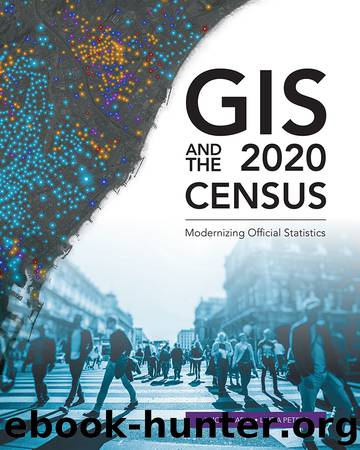GIS and the 2020 Census by Amor Laaribi

Author:Amor Laaribi
Language: eng
Format: epub
Tags: LCSH: Census—Methodology. | Census—Geographic information systems.
Publisher: Esri Press
Published: 2019-04-15T00:00:00+00:00
Figure 6.13. Boundary change in Los Angeles, CA—comparing 1990 with 2000 tract boundaries. The black boundaries are 1990, and the green boundaries are 2000. In the map, the two boundaries overlap (black and green lines), the 1990 boundaries were dropped (black lines only), and new 2000 boundaries were drawn (green lines only).
Moreover, a fundamental component that can facilitate change analysis is the compilation of a table of correspondence (concordance) to record the changes and data reassignments and that can be provided to census data users. The table would consist of compatibility or equivalency files and would list the codes of each EA in the current census and the corresponding code in a previous enumeration. This process ensures that if units have been split or aggregated, the split or aggregate would be indicated in these files. Besides the monitoring of the changes to be brought to the geographic base, other considerations relate to standards and classifications. Indeed, to provide comparability between censuses, it is advisable to use the existing metadata standards and revise the classifications, concord them with the previous ones, and add footnotes to the concordance table to indicate them.
Cloud considerations in census activities
Cloud computing is probably the most used buzzword in the IT community today.26 Cloud providers charge for cloud-computing services based on usage, like home utilities such as water or electricity. Cloud computing is becoming increasingly popular for data storage, analysis, and dissemination, and organizations and end users are turning to cloud-computing services for these reasons:
•Cost benefits—the up-front costs are reduced on IT resources and operational expenses, including the traditional need for IT administrators to manage computer resources.
•Speed—organizations acquire and operate necessary resources delivered in almost real time, instead of much time needed to plan, acquire, and set up their own resources.
•Global scale—the delivery of a scalable amount of IT resources in terms of computing power, storage, and bandwidth commensurate with demand at the right time and the right geographic location.
•Productivity—the IT teams of the organizations, spared from spending time on IT resources management, can focus on achieving their more important core businesses.
•Performance and reliability—allowing users and organizations to store and process data either in a privately owned cloud or on a third-party server in a well-maintained, secure data center. The data center is regularly upgraded to the latest computing hardware, thus making data-accessing mechanisms more efficient and reliable.27
The three main types of cloud-computing services are infrastructure as a service (IaaS), platform as a service (PaaS), and software as a service (SaaS).
•IaaS is the most basic category of cloud-computing services, allowing consumers to rent the IT infrastructure (servers, processing, storage, networks, operating systems, and other computing resources) from a cloud provider on demand and typically on a subscription basis. Examples of IaaS include Amazon® Web Services (AWS), Microsoft® Azure, and Google® Compute Engine.
•PaaS provides consumers with cloud-computing services that supply an on-demand environment for developing, testing, delivering, and managing software applications, including web or mobile apps. Examples of PaaS include AWS, AWS Elastic Beanstalk, Google® App Engine, and Heroku®.
Download
This site does not store any files on its server. We only index and link to content provided by other sites. Please contact the content providers to delete copyright contents if any and email us, we'll remove relevant links or contents immediately.
| CAD & CAM | Holography |
| Imaging Systems | Remote Sensing & GIS |
Whiskies Galore by Ian Buxton(40332)
Introduction to Aircraft Design (Cambridge Aerospace Series) by John P. Fielding(32338)
Small Unmanned Fixed-wing Aircraft Design by Andrew J. Keane Andras Sobester James P. Scanlan & András Sóbester & James P. Scanlan(32141)
Craft Beer for the Homebrewer by Michael Agnew(17447)
Turbulence by E. J. Noyes(7039)
The Complete Stick Figure Physics Tutorials by Allen Sarah(6638)
Kaplan MCAT General Chemistry Review by Kaplan(6054)
The Thirst by Nesbo Jo(5786)
Bad Blood by John Carreyrou(5769)
Learning SQL by Alan Beaulieu(5412)
Weapons of Math Destruction by Cathy O'Neil(5037)
Man-made Catastrophes and Risk Information Concealment by Dmitry Chernov & Didier Sornette(4737)
iGen by Jean M. Twenge(4702)
Digital Minimalism by Cal Newport;(4544)
Life 3.0: Being Human in the Age of Artificial Intelligence by Tegmark Max(4508)
Audition by Ryu Murakami(4099)
1,001 ASVAB Practice Questions For Dummies by Powers Rod(4039)
Electronic Devices & Circuits by Jacob Millman & Christos C. Halkias(4029)
Pale Blue Dot by Carl Sagan(4001)
